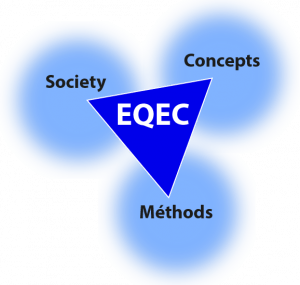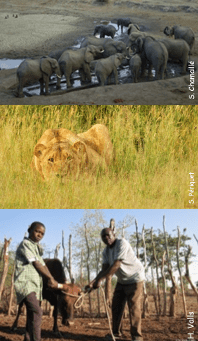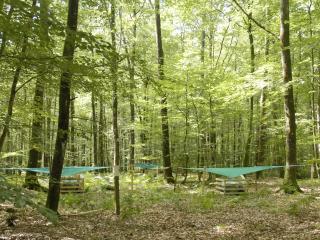Quantitative and Evolutionary Ecology of Communities Group
Members

Doctorante
UCBL

Professeure des universités
VetAgro-Sup
Tel: 33 04 72 43 27 56

Directeur de recherche
CNRS
Tel: 33 04 72 43 27 57

Doctorant
UCBL
Tel: 04 72 44 81 42

Doctorant
CNRS
Tel: 04 72 44 81 42
Doctorant
VetAgro-Sup

Maître de conférences
UCBL
Tel: 04 72 44 81 42
Doctorant
UCBL


Professeur des universités
UCBL
Tel: 33 04 72 43 27 56

Professeur des universités
UCBL

Directeur de recherche
CNRS
Tel: 33 04 72 43 27 56

Maîtresse de conférences
UCBL
Tel: 33 04 72 43 29 02
Maître de conférences
UCBL
Tel: 33 04 72 43 29 02

Our research activities, focused on interspecific interactions (community ecology), aim to better understand the ecological and evolutionary processes structuring species assemblages and biodiversity at different temporal and spatial scales. Our team addresses these major issues using contrasting biological models (communities of large African mammals, insects, microbiota, plants) from 3 complementary angles:
- Our work is strongly anchored in the conceptual framework of evolutionary biology by studying (i) the diversity of adaptive responses implemented by organisms to selective pressures in their environment, (ii) their consequences on population demography and ultimately (iii) the dynamics and composition of species communities.
- Our research is closely linked to societal issues of biodiversity conservation and management by integrating both the functioning of socio-ecological systems and the context of climate change. We conduct experimental studies, manage and ensure the long-term monitoring of several community observation networks.
- Methodological issues also occupy a central place in our team, with the development of new tools for statistical processing and modeling of ecological data. This activity leads to the development of methods and software that we develop and distribute freely.
Research programs

Functioning of African savanna communities
The Hwange LTSER (Long-Term Socio-Ecological Research site in Zimbabwe hosts a long-term interdisciplinary research program that focuses on the functioning of plant and animal communities within the Hwange National Park and the interactions between this protected area and humans living in its periphery. Based on this program, three axes are developed: (1) studying the population dynamics of elephants, exploring their impact and that of management policies on the socio-ecosystem functioning; (2) Understanding the extent to which interactions within and between trophic levels are sensitive to management actions (e.g. sport hunting, water management) and climate change; (3) Decoding human ecology and human-wildlife coexistence mechanisms towards integrated conservation and sustainable functioning of the socio-ecosystem. This research is complemented by more recent works in the Hluhluwe-iMfolozi Park and in the Madikwe reserve in South Africa, which focus on the role of environmental conditions on the hunting success of large African carnivores. We work in close collaboration with the IRL (International Research Lab) Rehabs.
Involved group members : Alice Bernard, Laura Lacomme, Aïssa Morin, Lisa Nicvert, Elie Pedarros, Yolan Richard, Marion Valeix*

Masting and the community dynamics of seed consumers
Masting is a reproductive strategy often encountered in perennial plants, characterized by fructifications highly fluctuating in time and being synchronized at the population level. The seeds produced that way constitute a pulsed resource with a strong impact on the eco-evolutionary dynamics of seed-consuming communities and forest regeneration. Our lack of knowledge of this system still impedes our understanding of the dynamics of temperate forest ecosystems and its future in the context of climate change. Our work carried out on oak forests aims to better understand (i) the proximal causes of masting, (ii) the mechanisms underlying the coexistence of species competing for such highly fluctuating resource and (iii) the co-evolution of consumer exploitation strategies for the fluctuating resource and forest tree fruiting strategies. On the basis of the results obtained, scenarii will be proposed on the future of forest regeneration under climate change, that may serve forest management.
Involved group members : Marie-Claude Bel-Venner*, Emilie Fleurot, Léa Keurinck, Jean Lobry, Samuel Venner

The spread of antibiotic resistance genes in bacteria
Antibiotic resistance is recognized as one of the greatest current threats to human health, and the mobile genetic elements (MGEs) that circulate in bacterial populations and communities are the main vehicles. To understand the dynamics and diversity of MGEs in bacterial pangenomes and the emergence of antibiotic resistance genes, we propose to go beyond the framework of conventional genomics by considering pangenomes as complex ecological communities. In the Ab-One program, we mobilize the concepts and tools developed in community ecology based on an integrative approach (monitoring of bacterial populations/communities evolving in contrasting environments -One-Health approaches-, pan-genomic analyses, experimentation in molecular and cellular microbiology, mathematical modelling). This program is currently focused on the dynamics of MGEs in Acinetobacter baumannii, an antibiotic-resistant microorganism classified as a priority by the WHO. Other more general approaches will illustrate the relevance of this new conceptual framework to understand the dynamics and diversity of MGEs in bacterial pangenomes. This program, co-piloted by our team and a team from CIRI (Horigene) involves the participation of 9 organizations (6 from Lyon -LBBE, CIRI, MMSB, HCL, LEM, VetAgro Sup-, Institut Pasteur (Paris), LMGM (Toulouse ), Robert Koch Institute (Germany)).
Involved group members : Stéphane Dray, Rémi Tuffet, Samuel Venner*

Statistical analysis of ecological data
Understanding the structure and dynamics of species assemblages, and the processes behind them, requires collecting data that are becoming increasingly complex owing to the sophisticated technological developments made available for their acquisition (e.g. GPS, loggers, satellite imagery, molecular data). We are developing new methods for analysing such data, that provide new insights into the ecological processes at work in communities. Multivariate analysis methods allow the analysis of spatial structures, accounting for various information on species (functional traits, morphology, phylogeny), the spatio-temporal variation of species-environment relationships or the multifaceted perception of the protected human-environment relationship. We also model multi-'omics' dose-response data within communities in order to better understand the Adverse Outcome Pathway (AOP) and to better appreciate the risks to the environment. These methodological innovations are made available to the scientific community through the development, distribution and maintenance of software (libraries for the R language: ade4, adegraphics, adephylo, ade4TkGUI, nlstools, fitdistrplus, DRomics, seqinr).
Involved group members: Marie Laure Delignette-Muller, Stéphane Dray*, Jean Lobry, Jean Thioulouse.
Publications
Display of 331 to 360 publications on 656 in total
Native plant resources to optimize the performances of forest rehabilitation in Mediterranean and tropical environment: some examples of nursing plant species that improve the soil mycorrhizal potential
Comptes Rendus. Biologies . 336 : 265-272
Journal article
see the publicationL'introduction d'acacias australiens pour réhabiliter des écosystèmes dégradés est-elle dépourvue de risques environnementaux ?
Bois et Forêts des Tropiques . 318 : 59-65
Journal article
see the publicationA new process to promote the use of controlled mycorrhization practice in forest nurseries
African Journal of Agricultural Research . 8 : 308--316
DOI: 10.5897/AJAR12.1642
Journal article
see the publicationTwo-component Bose gases with one-body and two-body couplings
Physical Review A : Atomic, molecular, and optical physics [1990-2015] . 88 : 063646
Journal article
see the publicationTurnover of soil bacterial diversity driven by wide-scale environmental heterogeneity.
Nature Communications . 4 : 1434
DOI: 10.1038/ncomms2431
Journal article
see the publicationMéthodes d'analyse multivariée pour l'étude de l'influence de la mycorhizosphère sur la structure et le fonctionnement des communautés bactériennes du sol
Des champignons symbiotiques contre la désertification. Ecosystèmes mediterranéens, tropicaux et insulaires . 978-2-7099-1949-4 : 474-508
Book chapter
see the publicationFrom Income to Capital Breeding: When Diversified Strategies Sustain Species Coexistence
PLoS ONE . 8 ( 9 ) : e76086
Journal article
see the publicationA guide for using functional diversity indices to reveal changes in assembly processes along ecological gradients
Journal of Vegetation Science . 24 : 794--806
DOI: 10.1111/jvs.12013
Journal article
see the publicationEcologie prédictive & changement planétaire
Prospective de l'Institut écologie & environnement du CNRS . hors s\'{e}rie : 9-44
Book chapter
see the publicationEndosymbiont diversity among sibling weevil species competing for the same resource
BMC Evolutionary Biology . 13 : 28
Journal article
see the publicationConference Report: Deuxièmes Rencontres R
The R Journal . 5/2 : 164--165
Journal article
see the publicationFunctional traits reveal processes driving natural afforestation at large spatial scales
PLoS ONE . 8 : e75219
Journal article
see the publicationReciprocal modulation of internal and external factors determines individual movements
Journal of Animal Ecology . 82 : 290--300
Journal article
see the publicationDoes local habitat fragmentation affect large-scale distributions? The case of a specialist grassland bird
Diversity and Distributions . 19 : 423--432
DOI: 10.1111/ddi.12019
Journal article
see the publicationThe exotic legume tree species, Acacia mearnsii, alters microbial soil functionalities and the early development of a native tree species, Quercus suber, in North Africa
Soil Biology and Biochemistry . 65 : 172--179
Journal article
see the publicationEctomycorrhizal diversity enhances growth and nitrogen fixation of Acacia mangium seedlings
Soil Biology and Biochemistry . 57 : 468-476
Journal article
see the publicationAustralian acacia introduction to rehabilitate degraded ecosystems is it free of environmental risks?
Bois et Forêts des Tropiques . 318 ( 4 ) : 59-65
Journal article
see the publicationPhylogenetic turnover in tropical tree communities: impact of environmental filtering, biogeography and mesoclimatic niche conservatism
Global Ecology and Biogeography . 21 ( 10 ) : 1007-1016
Journal article
see the publicationPhylogenetic turnover in tropical tree communities - testing evolutionary and ecological hypotheses on species assembly rules at contrasting spatial scales
49th Annual Meeting of the Association for Tropical Biology and Conservation (ATBC), "Ecology, Evolution and Sustainable Use of Tropical Biodiversity .
Conference paper
see the publicationRelationships of digestibility and intake by sheep of whole-crop cereal hays with different chemical, biological and physical methods
Small Ruminant Research . 108 ( 1-3 ) : 73-76
Journal article
see the publicationEstimating immigration in neutral communities: theoretical and practical insights into the sampling properties
Methods in Ecology and Evolution . 3 ( 1 ) : 152-161
Journal article
see the publicationThe role of epiphytism in architecture and evolutionary constraint within mycorrhizal networks of tropical orchids
Molecular Ecology . 21 ( 20 ) : 5098-5109
Journal article
see the publicationEcophylogenetics: advances and perspectives
Biological Reviews . 87 ( 4 ) : 769-785
Journal article
see the publicationMultivariate analyses in soil microbial ecology: a new paradigm
Environmental and Ecological Statistics . 19 ( 4 ) : 499--520
Journal article
see the publicationResponse of native soil microbial functions to the controlled mycorrhization of an exotic tree legume, Acacia holosericea in a Sahelian ecosystem
Mycorrhiza . 22 ( 3 ) : 175--187
Journal article
see the publicationRestoring native forest ecosystems after exotic tree plantation in Madagascar: combination of the local ectotrophic species Leptolena bojeriana and Uapaca bojeri mitigates the negative influence of the exotic species Eucalyptus camaldulensis and Pinus pat
Biological Invasions . 14 ( 11 ) : 2407--2421
Journal article
see the publicationPutative endosymbiont-mediated coexistence of weevil sibling species competing with each other
7. International Symbiosis Society (ISS) Congress "The earth’s vast symbiosphere" .
Poster
see the publicationContrasted breeding strategies in four sympatric sibling insect species: when a proovigenic and capital breeder copes with a stochastic environment
Functional Ecology . 26 ( 1 ) : 198-206
Journal article
see the publicationModeling of Clostridium perfringens vegetative cell inactivation in beef-in-sauce products: A meta-analysis using mixed linear models
International journal of food microbiology . 154 : 44--51
Journal article
see the publicationWhat to do with NOECS/NOELS - prohibition or innovation?
Integr Environ Assess Manag . 8 : 764--766
DOI: 10.1002/ieam.1350
Journal article
see the publication
You also, comment on this article